Distribution, Enrichment and Transport of Trace Metals in Sediments from the Dagu River Estuary in the Jiaozhou Bay, Qingdao, China
Abstract
:1. Introduction
2. Materials and Methods
2.1. Study Area
2.2. Sampling
2.3. Analytical Methods
2.4. Assessment of Sediment Contamination
2.5. Geostatistical Methods
3. Results
3.1. Sediment Characteristics
3.2. Heavy Metals and Metalloids Concentrations
| Locations | Cu | Pb | Zn | Cr | Cd | As | Hg | References |
|---|---|---|---|---|---|---|---|---|
| Dagu River | 15.68 (5.20~50.20) | 23.30 (10.50~33.30) | 35.01 (10.20~83.00) | 34.94 (6.69~71.20) | 0.05 (0.04~0.13) | 2.79 (0.56~7.56) | 0.02 (0.005~0.140) | This study |
| Dagu River Estuary | 24.56 (4.90~50.10) | 28.14 (25.40~31.90) | 62.84 (24.20~95.10) | 61.06 (23.00~87.80) | 0.07 (0.04~0.10) | 6.12 (4.0~10.8) | 0.030 (0.005~0.055) | This study |
| Intertidal Jiaozhou Bay | 38.8 | 55.2 | 107.4 | 69.9 | 0.42 | 9.2 | na | [9] |
| Liaodong Bay | 19.4 | 31.8 | 71.7 | 46.4 | na | 8.3 | 0.04 | [43] |
| Luanhe River Esturary | 18.76 | 30.98 | 44.63 | 41.14 | 0.09 | 7.21 | 0.02 | [4] |
| Coastal Bohai Bay | 38.5 | 34.7 | 131.1 | 101.4 | 0.22 | na | na | [52] |
| Laizhou Bay | 22 | 21.9 | 60.4 | 60 | 0.12 | 12.7 | na | [55] |
| Changjiang Estuary | 30.7 | 27.3 | 94.3 | 78.9 | 0.26 | na | na | [53] |
| Pearl River Estuary | 46.2 | 59.3 | 150.1 | 89 | na | na | na | [54] |
| MSQ-1 | 35 | 60 | 150 | 80 | 0.5 | 20 | 0.2 | AQSIQ (2002) |
4. Discussion
4.1. Metals Contamination
4.1.1. Sediment Quality
4.1.2. Enrichment Factor (EF)
4.2. Metals Control Factors and Sources
4.3. Metals Transport
5. Conclusions
Author Contributions
Funding
Acknowledgments
Conflicts of Interest
References
- Liu, J.; Cao, K.; Yin, P.; Gao, F.; Chen, X.; Zhang, Y.; Yu, Y. The Sources and Transport Patterns of Modern Sediments in Hangzhou Bay: Evidence from Clay Minerals. J. Ocean Univ. China 2018, 17, 1352–1360. [Google Scholar] [CrossRef]
- Song, H.; Liu, J.; Yin, P.; Zhang, Y.; Chen, X. Characteristics of Heavy Minerals and Quantitative Provenance Identification of Sediments from the Muddy Area Outside the Oujiang Estuary Since 5.8 kyr. J. Ocean Univ. China 2018, 17, 1325–1335. [Google Scholar] [CrossRef]
- Li, M.; Yin, P.; Duan, X.; Liu, J.; Qiu, J.; Phung, V.P. Land-Use Changes and Human Driving in and Near the Yangtze River Delta from 1995–2015. J. Ocean Univ. China 2018, 17, 1361–1368. [Google Scholar] [CrossRef]
- Liu, J.; Yin, P.; Chen, B.; Gao, F.; Song, H.; Li, M. Distribution and contamination assessment of heavy metals in surface sediments of the Luanhe River Estuary, northwest of the Bohai Sea. Mar. Pollut. Bull. 2016, 109, 633–639. [Google Scholar] [CrossRef] [PubMed]
- Song, H.; Liu, J.; Yin, P.; Zhang, Y. Distribution, enrichment and source of heavy metals in Rizhao offshore area, southeast Shandong Province. Mar. Pollut. Bull. 2017, 119, 175–180. [Google Scholar] [CrossRef] [PubMed]
- Xu, F.J.; Hu, B.; Dou, Y.G.; Song, Z.J.; Liu, X.T.; Yuan, S.Q.; Sun, Z.L.; Li, A.C.; Yin, X.B. Prehistoric heavy metal pollution on the continental shelf off Hainan Island, South China Sea: From natural to anthropogenic impacts around 4.0 kyr BP. Holocene 2018, 28, 455–463. [Google Scholar] [CrossRef]
- Zhou, Z.; Li, X.; Chen, L.; Li, B.; Liu, T.; Ai, B.; Yang, L.; Liu, B.; Chen, Q. Macrobenthic assemblage characteristics under stressed waters and ecological health assessment using AMBI and M-AMBI: A case study at the Xin’an River Estuary, Yantai, China. Acta Oceanol. Sin. 2018, 37, 77–86. [Google Scholar] [CrossRef]
- Xu, F.; Liu, Z.; Cao, Y.; Qiu, L.; Feng, J.; Xu, F.; Tian, X. Assessment of heavy metal contamination in urban river sediments in the Jiaozhou Bay catchment, Qingdao, China. Catena 2017, 150, 9–16. [Google Scholar] [CrossRef]
- Xu, F.; Qiu, L.; Cao, Y.; Huang, J.; Liu, Z.; Tian, X.; Li, A.; Yin, X. Trace metals in the surface sediments of the intertidal Jiaozhou Bay, China: Sources and contamination assessment. Mar. Pollut. Bull. 2016, 104, 371–378. [Google Scholar] [CrossRef] [PubMed]
- Tchounwou, P.B.; Yedjou, C.G.; Patlolla, A.K.; Sutton, D.J. Heavy Metals Toxicity and the Environment. In Experientia Supplementum; Springer Science and Business Media LLC: Berlin, Germany, 2012; Volume 101, pp. 133–164. [Google Scholar]
- Burton G, A. Sediment quality criteria in use around the world. Limnology 2002, 3, 65–76. [Google Scholar] [CrossRef]
- Ra, K.; Kim, E.S.; Kim, K.T.; Kim, J.K.; Lee, J.M.; Choi, J.Y. Assessment of heavy metal contamination and its ecological risk in the surface sediments along the coast of Korea. J. Coast. Res. 2013, 118, 105–110. [Google Scholar] [CrossRef]
- Sun, J.; Rong, J.; Zheng, Y.; Ma, D.; Lan, X. Risk Assessment of Heavy Metal Contaminated Dagu River Sediments. Procedia Environ. Sci. 2011, 8, 764–772. [Google Scholar] [CrossRef] [Green Version]
- Liang, X.; Song, J.; Duan, L.; Yuan, H.; Li, X.; Li, N.; Qu, B.; Wang, Q.; Xing, J. Source identification and risk assessment based on fractionation of heavy metals in surface sediments of Jiaozhou Bay, China. Mar. Pollut. Bull. 2018, 128, 548–556. [Google Scholar] [CrossRef] [PubMed]
- Kang, X.; Song, J.; Yuan, H.; Li, X.; Li, N.; Duan, L. Historical trends of anthropogenic metals in sediments of Jiaozhou Bay over the last century. Mar. Pollut. Bull. 2018, 135, 176–182. [Google Scholar] [CrossRef] [PubMed]
- Wang, S.J.; Li, X.P.; Schertl, H.P.; Feng, Q.D. Petrogenesis of early cretaceous andesite dykes in the Sulu orogenic belt, eastern China. Mineral. Petrol. 2019, 113, 77–97. [Google Scholar] [CrossRef]
- Du, Q.; Han, Z.; Shen, X.; Han, C.; Song, Z.; Gao, L.; Han, M.; Zhong, W. Geochronology and geochemistry of Permo-Triassic sandstones in eastern Jilin Province (NE China): Implications for final closure of the Paleo-Asian Ocean. Geosci. Front. 2019, 10, 683–704. [Google Scholar] [CrossRef]
- Pang, Y.-M.; Guo, X.-W.; Han, Z.-Z.; Zhang, X.-H.; Zhu, X.-Q.; Hou, F.-H.; Han, C.; Song, Z.-G.; Xiao, G.-L. Mesozoic–Cenozoic denudation and thermal history in the Central Uplift of the South Yellow Sea basin and the implications for hydrocarbon systems: Constraints from the CSDP-2 borehole. Mar. Pet. Geol. 2019, 99, 355–369. [Google Scholar] [CrossRef]
- Song, Z.G.; Han, C.; Liu, H.; Han, Z.Z.; Yan, J.L.; Zhong, W.J.; Gao, L.H.; Du, Q.X.; Han, M.; Li, J.J. Early-Middle Ordovician intermediate-mafic and ultramafic rocks in central Jilin Province, NE China: Geochronology, origin, and tectonic implications. Mineral. Petrol. 2019, 113, 393–415. [Google Scholar] [CrossRef]
- Pang, Y.M.; Zhang, X.H.; Guo, X.W.; Xiao, G.L.; Zhu, X.Q. Mesozoic and Cenozoic tectono-thermal evolution modeling in the Northern South Yellow Sea Basin. Chin. J. Geophys. Chin. Ed. 2017, 60, 3177–3190. [Google Scholar]
- Han, C.; Han, M.; Jiang, Z.X.; Han, Z.Z.; Li, H.; Song, Z.G.; Zhong, W.J.; Liu, K.X.; Wang, C.H. Source analysis of quartz from the Upper Ordovician and Lower Silurian black shale and its effects on shale gas reservoir in the Southern Sichuan Basin and its periphery. China Geol. J. 2019, 54, 439–449. [Google Scholar] [CrossRef]
- Pang, Y.M.; Zhang, X.H.; Guo, X.W.; Xiao, G.L.; Han, Z.Z. Basin modeling in the initial stage of exploration: a case study from the North Subbasin of the South Yellow Sea Basin. Acta Oceanol. Sin. 2017, 36, 65–78. [Google Scholar] [CrossRef]
- Meng, Y.; Santosh, M.; Li, R.; Xu, Y.; Hou, F. Petrogenesis and tectonic implications of Early Cretaceous volcanic rocks from Lingshan Island in the Sulu Orogenic Belt. Lithos 2018, 312, 244–257. [Google Scholar] [CrossRef]
- Wei, P.F.; Yu, X.F.; Li, D.P.; Liu, Q.; Yu, L.D.; Li, Z.P.; Geng, K.; Zhang, Y.; Sun, Y.Q.; Chi, N.J. Geochemistry, Zircon U–Pb Geochronology, and Lu–Hf Isotopes of the Chishan Alkaline Complex, Western Shandong, China. Minerals 2019, 9(5), 293. [Google Scholar] [CrossRef]
- Cao, Y.; Liu, L.; Wang, C.; Kang, L.; Li, D.; Yang, W.; Zhu, X. Timing and nature of the partial melting processes during the exhumation of the garnet–bearing biotite gneiss in the southern Altyn Tagh HP/UHP belt, Western China. J. Asian Earth Sci. 2019, 170, 274–293. [Google Scholar] [CrossRef]
- Wang, S.; Schertl, H.-P.; Pang, Y. Geochemistry, geochronology and Sr–Nd–Hf isotopes of two types of early Cretaceous granite porphyry dykes in the Sulu orogenic belt, eastern China. Can. J. Earth Sci. 2019. [Google Scholar] [CrossRef]
- Li, X.P.; Guo, J.H.; Zhao, G.C.; Li, H.K.; Song, Z.J. Formation of the Paleoproterozoic calc-silicate and high-pressure mafic granulite in the Jiaobei terrane, eastern Shandong, China. Acta Petrol. Sin. 2011, 27, 961–968. [Google Scholar]
- Zhu, D.; Lü, D.; Shen, X.; Yang, Q.; Li, D.; Ren, T.; Yang, S. Discovery and Geological Significance of Neoproterozoic Metamorphic Granite in Jimo, Shandong Province, Eastern China. Acta Geol. Sin. 2016, 90, 2080–2096. [Google Scholar] [CrossRef]
- Chen, J.; Han, Z.; Zhang, X.; Fan, A.; Yang, R. Early diagenetic deformation structures of the Furongian ribbon rocks in Shandong Province of China—A new perspective of the genesis of limestone conglomerates. Sci. China Earth Sci. 2010, 53, 241–252. [Google Scholar] [CrossRef]
- Jin, A.; Li, J.; Hou, G. Timing and implications for the late Mesozoic geodynamic settings of eastern North China Craton: Evidences from K–Ar dating age and sedimentary–structural characteristics records of Lingshan Island, Shandong Province. J. Earth Syst. Sci. 2017, 126, 117. [Google Scholar]
- Qiu, J.; Liu, J.; Saito, Y.; Yin, P.; Zhang, Y.; Liu, J.; Zhou, L. Seismic morphology and infilling architecture of incised valleys in the northwest South Yellow Sea since the last glaciation. Cont. Shelf Res. 2019, 179, 52–65. [Google Scholar] [CrossRef]
- Wang, Y.P.; Gao, S.; Jia, J.J. Sediment distribution and transport patterns in Jiaozhou Bay and adjoining areas. Acta Geograp Hica Sin. 2000, 55, 449–458, (In Chinese with English abstract). [Google Scholar]
- Gao, S.; Wang, Y.P. Characteristics of sedimentary environment and tidal inlet evolution of Jiaozhou Bay. Adv. Mar. Sci. 2002, 20, 52–59, (In Chinese with English abstract). [Google Scholar]
- Li, N.S.; Yu, H.J.; Zhao, S.L. Natural Environment and Geological Evolution of Jiaozhou Bay; Ocean Press: Beijing, China, 2006; pp. 1–282. (In Chinese) [Google Scholar]
- Zhao, K.; Qiao, L.; Shi, J.; He, S.; Li, G.; Yin, P. Evolution of sedimentary dynamic environment in the western Jiaozhou Bay, Qingdao, China in the last 30 years. Estuar. Coast. Shelf Sci. 2015, 163, 244–253. [Google Scholar] [CrossRef]
- Folk, R.L.; Ward, W.C. Brazos River bar [Texas]; A study in the significance of grain size parameters. J. Sediment. Res. 1957, 27, 3–26. [Google Scholar] [CrossRef]
- Dou, Y.; Li, J.; Zhao, J.; Hu, B.; Yang, S. Distribution, enrichment and source of heavy metals in surface sediments of the eastern Beibu Bay, South China Sea. Mar. Pollut. Bull. 2013, 67, 137–145. [Google Scholar] [CrossRef]
- AQSIQ (Administration of Quality Supervision, Inspection and Quarantine of the People’s Republic of China). Marine Sediment Quality of China (GB 18668-2002); Standards Press of China: Beijing, China, 2002; pp. 1–2.
- Long, E.R.; Macdonald, D.D.; Smith, S.L.; Calder, F.D. Incidence of adverse biological effects within ranges of chemical concentrations in marine and estuarine sediments. Environ. Manag. 1995, 19, 81–97. [Google Scholar] [CrossRef]
- Long, E.R.; Field, L.J.; Macdonald, D.D. Predicting toxicity in marine sediments with numerical sediment quality guidelines. Environ. Toxicol. Chem. 1998, 17, 714–727. [Google Scholar] [CrossRef]
- Macdonald, D.D.; Carr, R.S.; Calder, F.D.; Long, E.R.; Ingersoll, C.G. Development and evaluation of sediment quality guidelines for Florida coastal waters. Ecotoxicology 1996, 5, 253–278. [Google Scholar] [CrossRef]
- Xia, P.; Meng, X.W.; Feng, A.P.; Yin, P.; Zhang, J.; Wang, X.Q. Geochemical characteristics of heavy metals in coastal sediments from the northern Beibu Gulf (SW China): The background levels and recent contamination. Environ. Earth Sci. 2012, 66, 1337–1344. [Google Scholar] [CrossRef]
- Hu, B.Q.; Li, J.; Zhao, J.T.; Yang, J.; Bai, F.L.; Dou, Y.G. Heavy metal in surface sediments of the Liaodong Bay, Bohai Sea: distribution, contamination, and sources. Environ. Monit. Assess. 2013, 185, 5071–5083. [Google Scholar] [CrossRef]
- Zhang, J.; Liu, C. Riverine Composition and Estuarine Geochemistry of Particulate Metals in China—Weathering Features, Anthropogenic Impact and Chemical Fluxes. Estuarine Coast. Shelf Sci. 2002, 54, 1051–1070. [Google Scholar] [CrossRef]
- Chen, C.-W.; Kao, C.-M.; Chen, C.-F.; Dong, C.-D. Distribution and accumulation of heavy metals in the sediments of Kaohsiung Harbor, Taiwan. Chemosphere 2007, 66, 1431–1440. [Google Scholar] [CrossRef]
- Gao, S.; Luo, T.-C.; Zhang, B.-R.; Zhang, H.-F.; Han, Y.-W.; Zhao, Z.-D.; Hu, Y.-K. Chemical composition of the continental crust as revealed by studies in East China. Geochim. Cosmochim. Acta 1998, 62, 1959–1975. [Google Scholar] [CrossRef]
- Taylor, R. Interpretation of the Correlation Coefficient: A Basic Review. J. Diagn. Med Sonogr. 1990, 6, 35–39. [Google Scholar] [CrossRef]
- Gao, S.; Collins, M. Net sediment transport patterns inferred from grain-size trends, based upon definition of “transport vectors. ” Sediment. Geol. 1992, 81, 47–60. [Google Scholar] [CrossRef]
- Mclaren, P.; Bowles, D. The Effects of Sediment Transport on Grain-Size Distributions. J. Sediment. Res. 1985, 55, 457–470. [Google Scholar]
- Gao, S. A FORTRAN program for grain-size trend analysis to define net sediment transport pathways. Comput. Geosci. 1996, 22, 449–452. [Google Scholar] [CrossRef]
- Folk, R.L.; Andrews, P.B.; Lewis, D.W. Detrital sedimentary rock classification and nomenclature for use in New Zealand. N. Z. J. Geol. Geophys. 1970, 13, 937–968. [Google Scholar] [CrossRef] [Green Version]
- Gao, X.; Chen, C.-T.A. Heavy metal pollution status in surface sediments of the coastal Bohai Bay. Water Res. 2012, 46, 1901–1911. [Google Scholar] [CrossRef]
- Zhang, W.; Feng, H.; Chang, J.; Qu, J.; Xie, H.; Yu, L. Heavy metal contamination in surface sediments of Yangtze River intertidal zone: An assessment from different indexes. Environ. Pollut. 2009, 157, 1533–1543. [Google Scholar] [CrossRef]
- Zhou, H.-Y.; Peng, X.-T.; Pan, J.-M. Distribution, source and enrichment of some chemical elements in sediments of the Pearl River Estuary, China. Cont. Shelf Res. 2004, 24, 1857–1875. [Google Scholar] [CrossRef]
- Xu, G.; Liu, J.; Pei, S.; Gao, M.; Hu, G.; Kong, X. Sediment properties and trace metal pollution assessment in surface sediments of the Laizhou Bay, China. Environ. Sci. Pollut. Res. 2015, 22, 11634–11647. [Google Scholar] [CrossRef] [PubMed]
- Zhang, C.; Yu, Z.-G.; Zeng, G.-M.; Jiang, M.; Yang, Z.-Z.; Cui, F.; Zhu, M.-Y.; Shen, L.-Q.; Hu, L. Effects of sediment geochemical properties on heavy metal bioavailability. Environ. Int. 2014, 73, 270–281. [Google Scholar] [CrossRef] [PubMed]
- Han, Z.; Gao, X.; Zhao, H.; Tucker, M.E.; Zhao, Y.; Bi, Z.; Pan, J.; Wu, G.; Yan, H. Extracellular and Intracellular Biomineralization Induced by Bacillus licheniformis DB1-9 at Different Mg/Ca Molar Ratios. Minerals 2018, 8, 585. [Google Scholar] [CrossRef]
- Han, Z.Z.; Yu, W.W.; Zhao, H.; Zhao, Y.H.; Tucker, E.M.; Yan, H.X. The Significant Roles of Mg/Ca Ratio, Cl− and SO42− in Carbonate Mineral Pre-cipitation by the Halophile Staphylococcus epidermis Y2. Minerals 2018, 8, 594. [Google Scholar] [CrossRef]
- Guo, K.; Zhai, S.-K.; Wang, X.-Y.; Yu, Z.-H.; Lai, Z.-Q.; Chen, S.; Song, Z.-J.; Ma, Y.; Chen, Z.-X.; Li, X.-H.; et al. The dynamics of the southern Okinawa Trough magmatic system: New insights from the microanalysis of the An contents, trace element concentrations and Sr isotopic compositions of plagioclase hosted in basalts and silicic rocks. Chem. Geol. 2018, 497, 146–161. [Google Scholar] [CrossRef]
- Wong, C.; Li, X.; Zhang, G.; Qi, S.; Peng, X. Atmospheric deposition of heavy metals in the Pearl River Delta, China. Atmos. Environ. 2003, 37, 767–776. [Google Scholar] [CrossRef] [Green Version]
- Järup, L. Hazards of heavy metal contamination. Br. Med. Bull. 2003, 68, 167–182. [Google Scholar] [CrossRef] [PubMed] [Green Version]
- Duan, X.; Liu, J.; Zhang, D.; Yin, P.; Li, Y.; Li, X. An assessment of human influences on sources of polycyclic aromatic hydrocarbons in the estuarine and coastal sediments of China. Mar. Pollut. Bull. 2015, 97, 309–318. [Google Scholar] [CrossRef] [PubMed]
- Duruibe, J.O.; Ogwuegbu, M.O.C.; Egwurugwu, J.N. Heavy metal pollution and human biotoxic effects. Int. J. Phys. Sci. 2007, 2, 112–118. [Google Scholar]
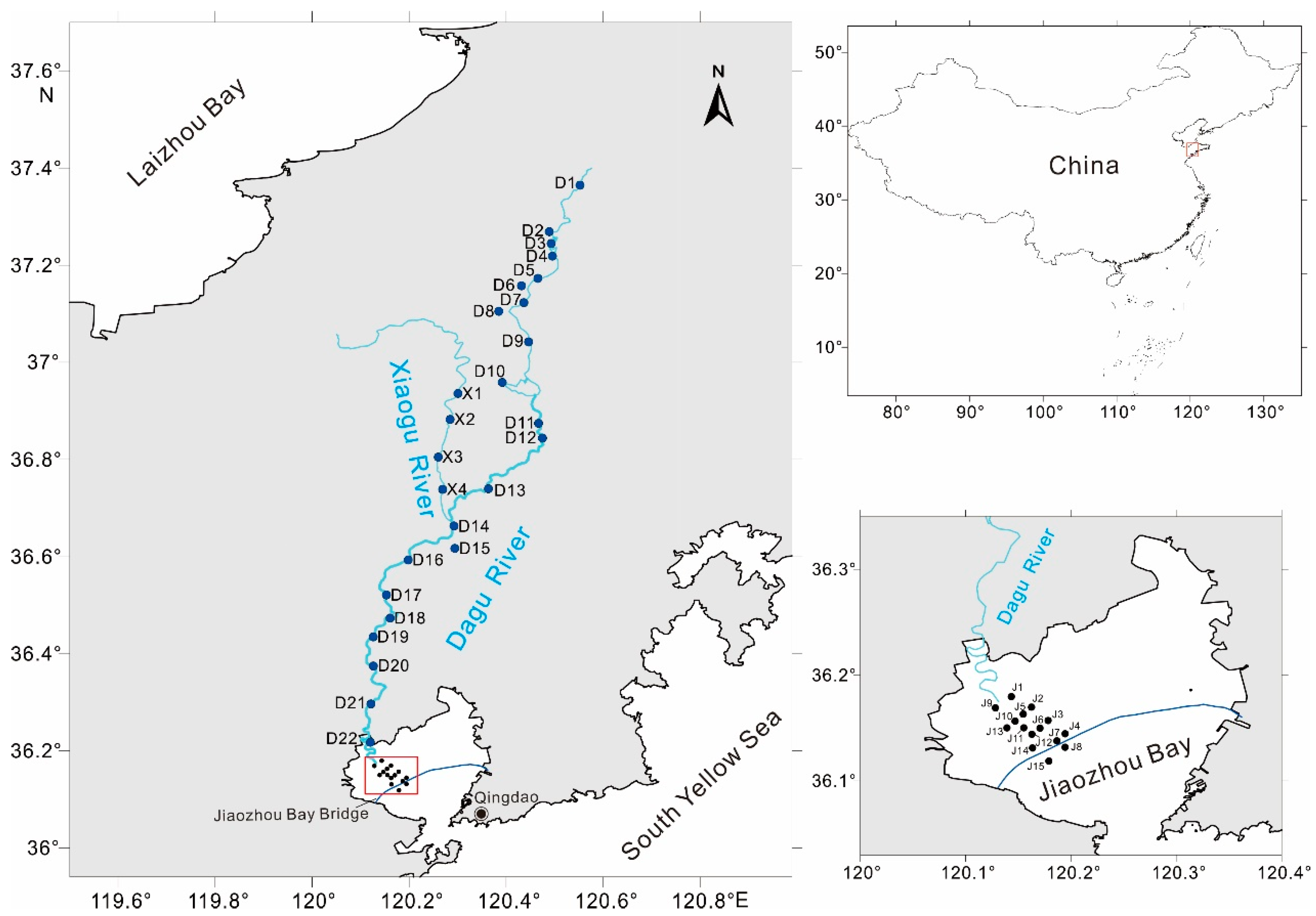
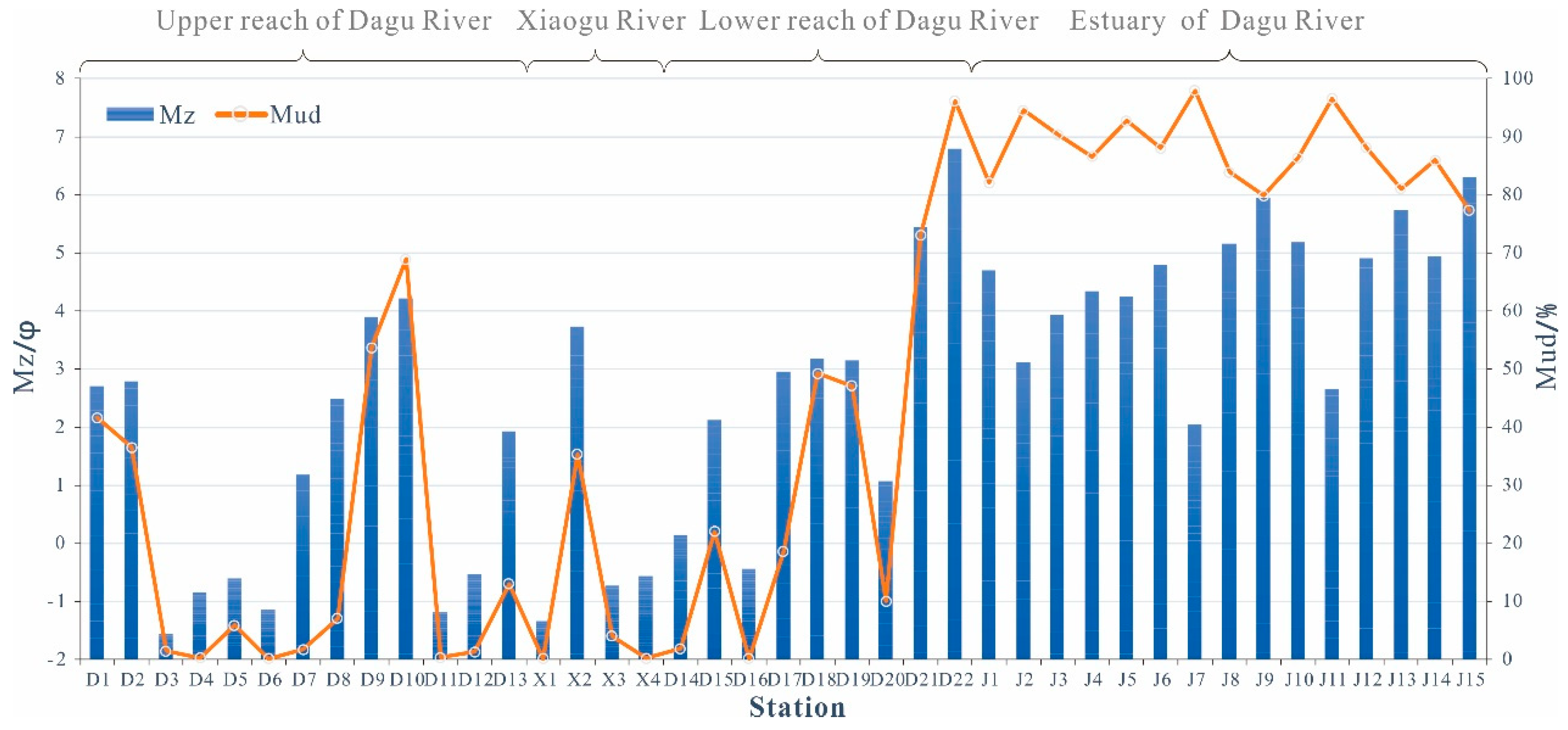
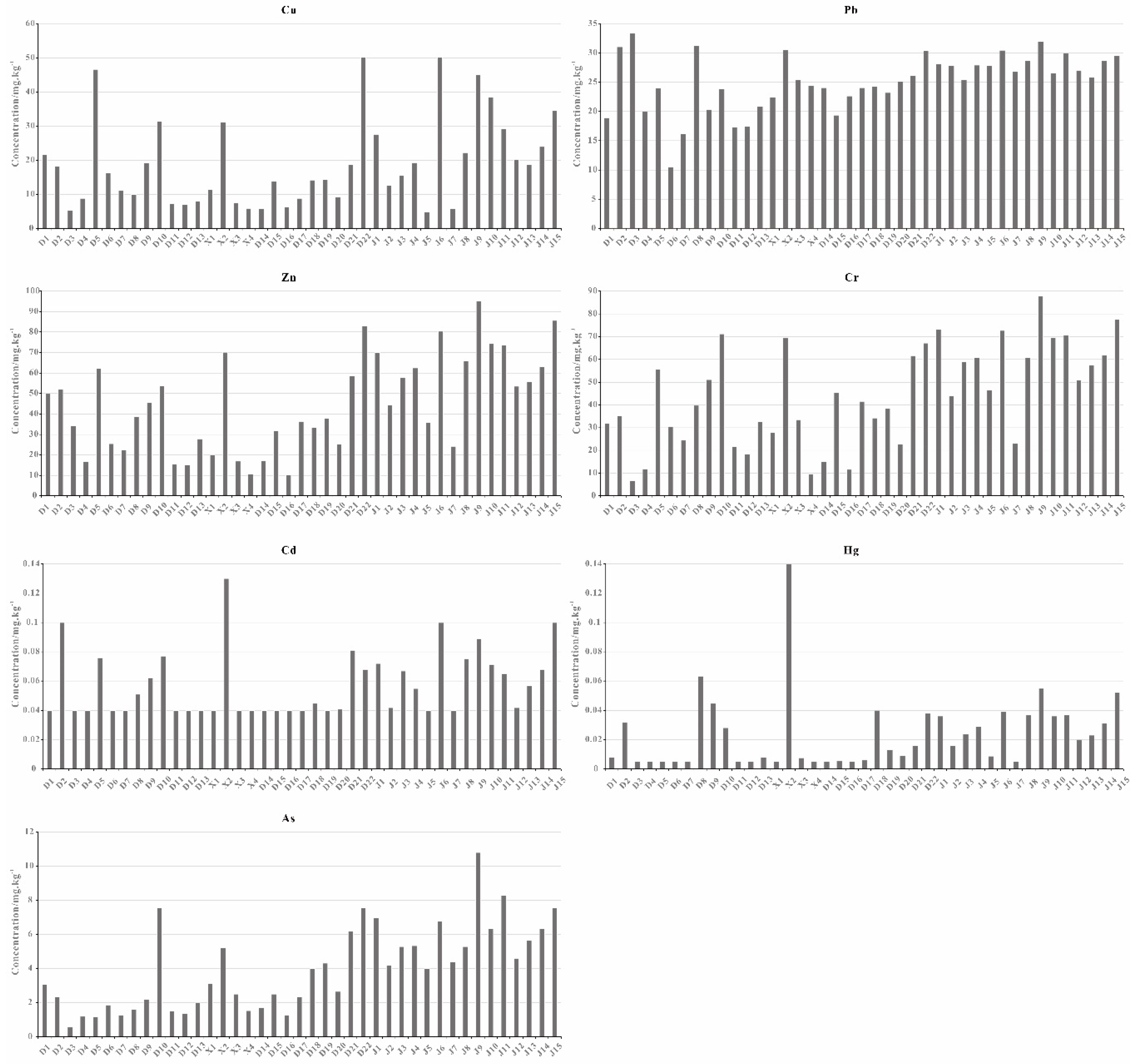
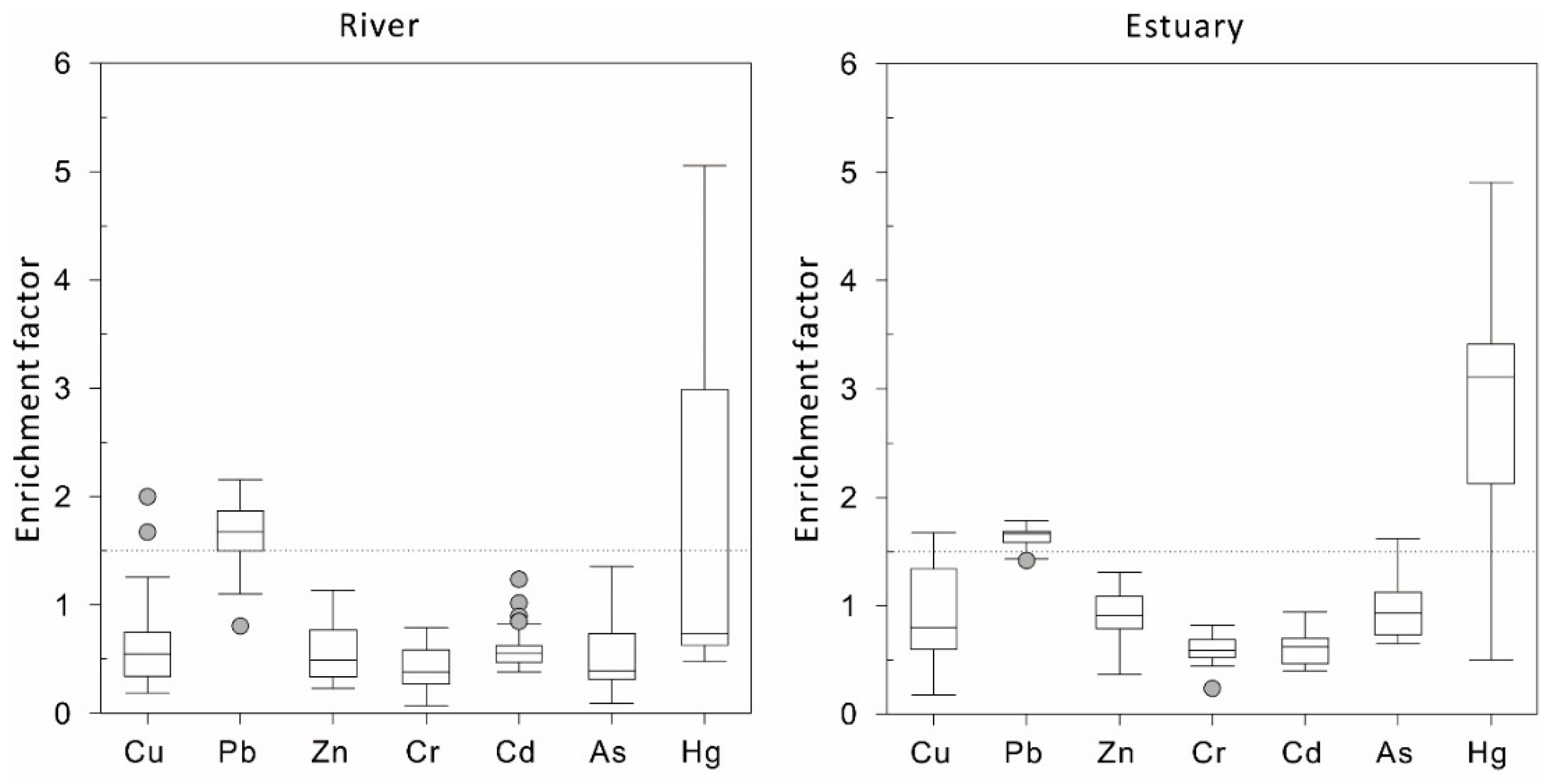
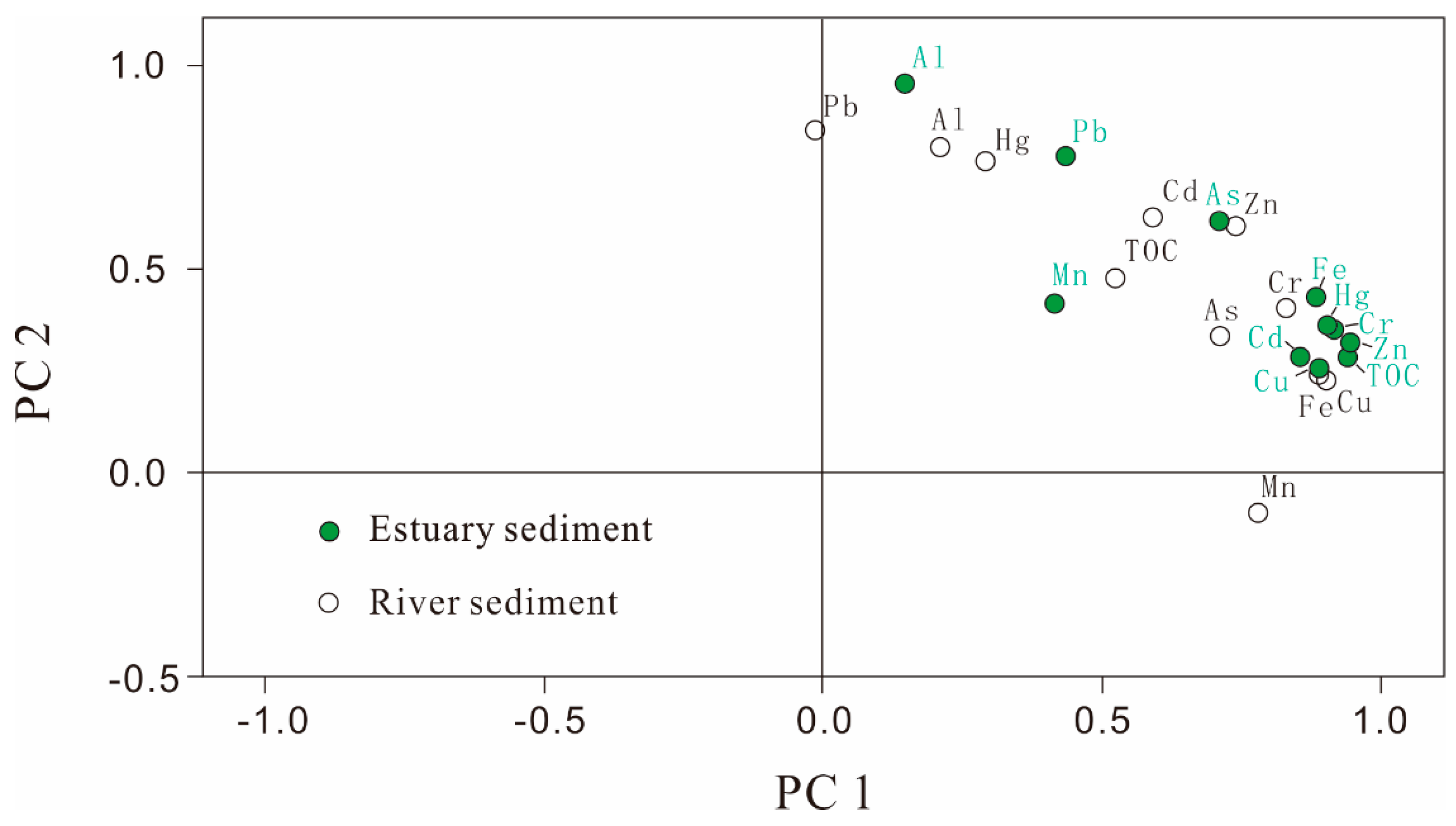
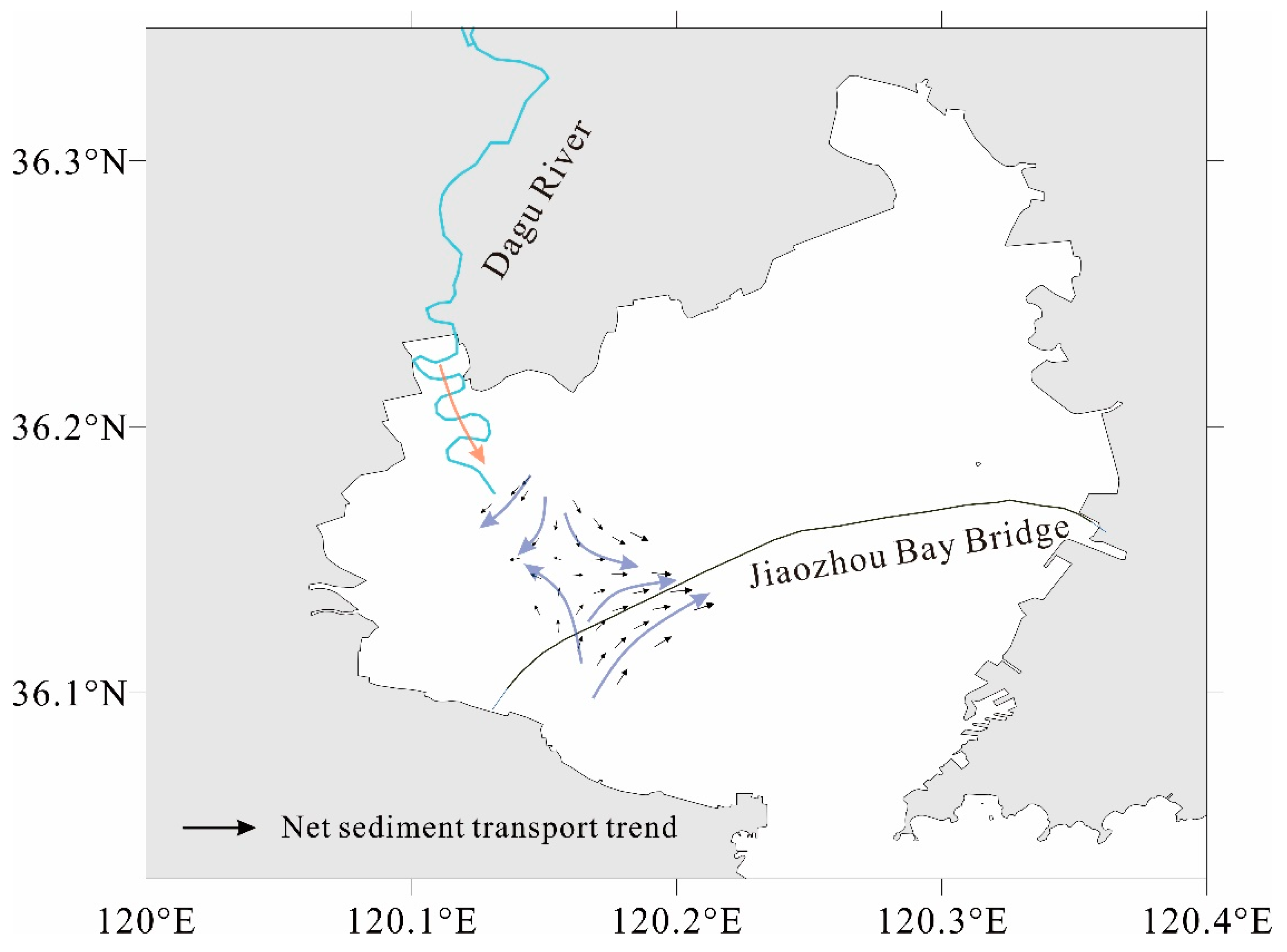
| Sediment Quality Guidelines | Locations | Cu | Pb | Zn | Cr | Cd | As | Hg |
|---|---|---|---|---|---|---|---|---|
| Threshold effect level (TEL) | 18.7 | 30.2 | 124 | 52.3 | 0.68 | 7.24 | 0.13 | |
| Probable effect level (PEL) | 108 | 112 | 271 | 160 | 4.21 | 41.6 | 0.7 | |
| Compared with TEL and PEL (% of samples in each guideline) | ||||||||
| <TEL (%) | Dagu River | 82.9 | 87.8 | 100 | 87.8 | 100 | 95.1 | 97.6 |
| Dagu River Estuary | 73.2 | 95.1 | 100 | 73.2 | 100 | 92.7 | 100 | |
| ≥TEL < PEL (%) | Dagu River | 17.1 | 12.2 | 0 | 12.2 | 0 | 4.9 | 2.4 |
| Dagu River Estuary | 26.8 | 4.9 | 0 | 26.8 | 0 | 7.3 | 0 | |
| Parameters | Locations | Cu | Pb | Zn | Cr | Cd | As | Hg |
|---|---|---|---|---|---|---|---|---|
| Mbackground [46] (mg/kg) | North China | 25 | 15 | 61 | 90 | 0.091 | 5.6 | 0.0094 |
| EF | Dagu River | 0.6 | 1.6 | 0.6 | 0.4 | 0.6 | 0.5 | 2.0 |
| 0.2~2.0 | 0.8~2.2 | 0.2~1.1 | 0.1~0.8 | 0.4~1.2 | 0.1~1.4 | 0.5~12.9 | ||
| Dagu River Estuary | 0.8 | 1.6 | 0.4 | 0.6 | 0.6 | 0.9 | 2.7 | |
| 0.2~1.6 | 1.4~1.8 | 0.4~1.3 | 0.2~0.8 | 0.4~0.9 | 0.6~1.6 | 0.5~4.9 |
| Variables | Al | Mn | Fe | TOC | Cu | Pb | Zn | Cr | Cd | As | Hg | Mz |
|---|---|---|---|---|---|---|---|---|---|---|---|---|
| Al | 1.00 | |||||||||||
| Mn | 0.10 | 1.00 | ||||||||||
| Fe | 0.48 * | 0.57 ** | 1.00 | |||||||||
| TOC | 0.34 | 0.29 | 0.48 * | 1.00 | ||||||||
| Cu | 0.41 * | 0.66 ** | 0.92 ** | 0.49 * | 1.00 | |||||||
| Pb | 0.61 ** | 0.10 | 0.15 | 0.37 | 0.23 | 1.00 | ||||||
| Zn | 0.72 ** | 0.43 * | 0.86 ** | 0.61 ** | 0.87 ** | 0.47 * | 1.00 | |||||
| Cr | 0.49 * | 0.49 * | 0.86 ** | 0.59 ** | 0.79 ** | 0.25 | 0.85 ** | 1.00 | ||||
| Cd | 0.48 * | 0.43 * | 0.66 ** | 0.68 ** | 0.65 ** | 0.48 * | 0.76 ** | 0.71 ** | 1.00 | |||
| As | 0.37 | 0.50 ** | 0.57 ** | 0.63 ** | 0.61 ** | 0.29 | 0.68 ** | 0.78 ** | 0.51 ** | 1.00 | ||
| Hg | 0.56 ** | 0.17 | 0.41 * | 0.40 * | 0.41 * | 0.49 * | 0.60 ** | 0.62 ** | 0.74 ** | 0.47 * | 1.00 | |
| Mz | 0.60 ** | 0.22 | 0.54 ** | 0.60 ** | 0.54 ** | 0.34 | 0.76 ** | 0.77 ** | 0.50 ** | 0.79 ** | 0.56 ** | 1.00 |
| Variables | Al | Mn | Fe | TOC | Cu | Pb | Zn | Cr | Cd | As | Hg | Mz |
|---|---|---|---|---|---|---|---|---|---|---|---|---|
| Al | 1.00 | |||||||||||
| Mn | 0.38 | 1.00 | ||||||||||
| Fe | 0.54 * | 0.57 * | 1.00 | |||||||||
| TOC | 0.39 | 0.46 | 0.96 ** | 1.00 | ||||||||
| Cu | 0.38 | 0.37 | 0.85 ** | 0.90 ** | 1.00 | |||||||
| Pb | 0.74 ** | 0.36 | 0.69 ** | 0.66 ** | 0.65 ** | 1.00 | ||||||
| Zn | 0.44 | 0.56 * | 0.98 ** | 0.97 ** | 0.92 ** | 0.65 ** | 1.00 | |||||
| Cr | 0.48 | 0.67 ** | 0.97 ** | 0.94 ** | 0.85 ** | 0.61 * | 0.97 ** | 1.00 | ||||
| Cd | 0.47 | 0.31 | 0.83 ** | 0.85 ** | 0.87 ** | 0.61 * | 0.88 ** | 0.84 ** | 1.00 | |||
| As | 0.70 ** | 0.43 | 0.92 ** | 0.86 ** | 0.79 ** | 0.74 ** | 0.86 ** | 0.85 ** | 0.73 ** | 1.00 | ||
| Hg | 0.47 | 0.48 | 0.97 ** | 0.96 ** | 0.87 ** | 0.68 ** | 0.98 ** | 0.94 ** | 0.90 ** | 0.86 ** | 1.00 | |
| Mz | 0.10 | 0.44 | 0.58 * | 0.55 * | 0.54 * | 0.22 | 0.65 ** | 0.66 ** | 0.60 * | 0.41 | 0.65 ** | 1.00 |
| Parameter | Dagu River | Dagu River Estuary | ||
|---|---|---|---|---|
| PC1 | PC2 | PC1 | PC2 | |
| Al | 0.21 | 0.80 | 0.15 | 0.96 |
| Mn | 0.78 | −0.10 | 0.41 | 0.41 |
| Fe | 0.89 | 0.24 | 0.88 | 0.43 |
| TOC | 0.52 | 0.47 | 0.94 | 0.28 |
| Cu | 0.90 | 0.23 | 0.89 | 0.26 |
| Pb | −0.02 | 0.84 | 0.43 | 0.78 |
| Zn | 0.74 | 0.60 | 0.94 | 0.32 |
| Cr | 0.83 | 0.41 | 0.90 | 0.36 |
| Cd | 0.59 | 0.63 | 0.85 | 0.28 |
| As | 0.71 | 0.34 | 0.71 | 0.61 |
| Hg | 0.30 | 0.76 | 0.92 | 0.35 |
| Eigenvalues | 4.73 | 3.31 | 6.61 | 2.84 |
| Percentage of Variances | 42.96 | 30.09 | 60.12 | 25.83 |
| Cumulative % Eigenvectors | 42.96 | 73.05 | 60.12 | 85.95 |
© 2019 by the authors. Licensee MDPI, Basel, Switzerland. This article is an open access article distributed under the terms and conditions of the Creative Commons Attribution (CC BY) license (http://creativecommons.org/licenses/by/4.0/).
Share and Cite
Liu, J.; Yin, P.; Chen, X.; Cao, K. Distribution, Enrichment and Transport of Trace Metals in Sediments from the Dagu River Estuary in the Jiaozhou Bay, Qingdao, China. Minerals 2019, 9, 545. https://doi.org/10.3390/min9090545
Liu J, Yin P, Chen X, Cao K. Distribution, Enrichment and Transport of Trace Metals in Sediments from the Dagu River Estuary in the Jiaozhou Bay, Qingdao, China. Minerals. 2019; 9(9):545. https://doi.org/10.3390/min9090545
Chicago/Turabian StyleLiu, Jinqing, Ping Yin, Xiaoying Chen, and Ke Cao. 2019. "Distribution, Enrichment and Transport of Trace Metals in Sediments from the Dagu River Estuary in the Jiaozhou Bay, Qingdao, China" Minerals 9, no. 9: 545. https://doi.org/10.3390/min9090545





